In the society of images that we are experiencing, images have brought lasting joy as well as lasting issues. The latter includes the monopoly of internet giants and the proliferation of images, as well as the increasingly open world of images and the protection of personal information. Of course, the Cryptoart craze on NFTs (non-fungible tokens) that has emerged since the post-pandemic era are enthusiastically discussed. These internet-based discussions surrounding images all seem to show a certain virtual nature in the world of images. It is inevitable that people subconsciously associate the current visual cultural life with the vocabulary including levitation, transient nature, immateriality and so on, as if the world of images created by the internet age was purely virtual and inaccessible. Perhaps there is a whole scene of illusion jointly created by digital technologies and the internet. And behind this, what is the appearance of “iconomy” that is constantly running and why is it called the instigator?


Exhibition View of “Le supermarché des images (The Supermarket of Images)”
On May 28th, 2021, “Le supermarché des images (The Supermarket of Images)” officially commenced at Red Brick Art Museum. With over 50 works by 39 artists or groups, the exhibition re-examines the essence of “iconomy” from five perspectives of images namely “Stocks”, “Raw Materials”, “Work”, “Values” and “Exchanges”. The metaphor of “supermarket” establishes a certain correspondence between the structure and the exhibits, and the consumption, production, transportation, and even openness to the public that can actually be found in the commercial filed of “supermarket”. Even for the self-help attribute, visitors can get a response from the process when they stroll among over 50 works.
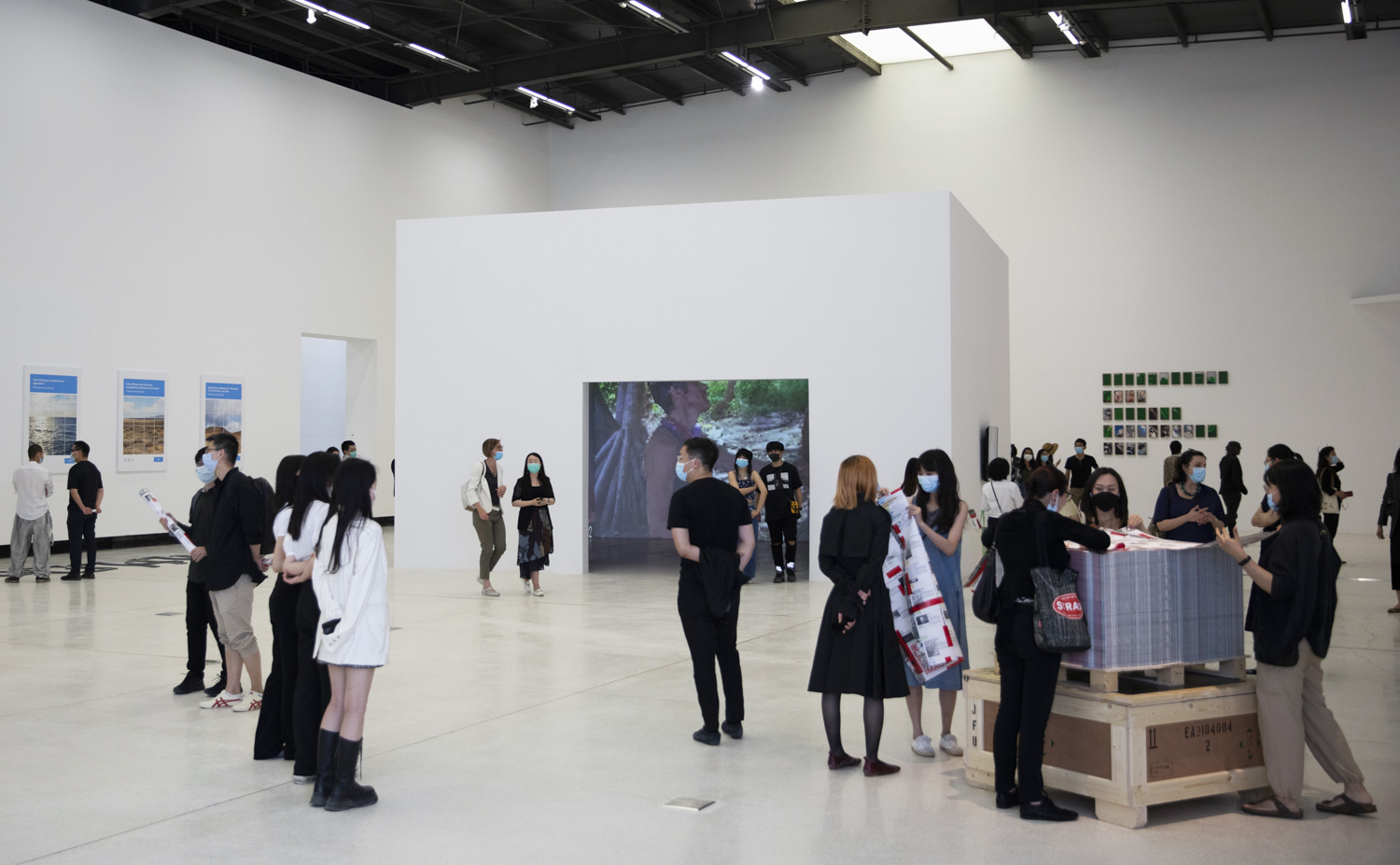
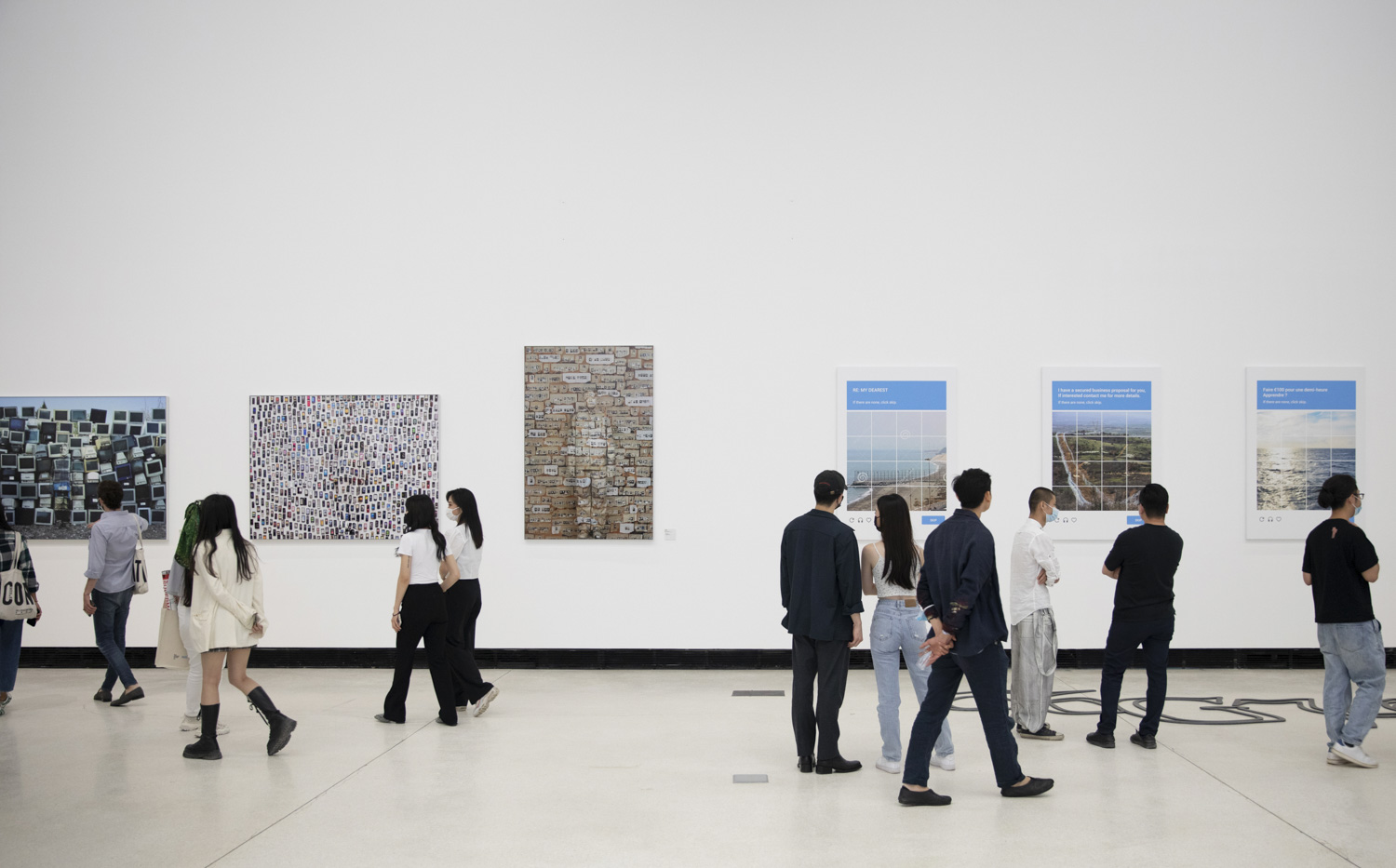

Exhibition View of “Le supermarché des images (The Supermarket of Images)”
I. Visible Images
Invisible Stocks/Raw Materials/Work
Peter Szendy, Professor of Comparative Literature and Humanities at Brown University, serves as the chief curator of this exhibition. The theme is inspired by the concept of “iconomy” that was developed in Peter Szendy’s 2017 book The Supermarket of the Visible: Towards a General Economy of Images (Le Supermarché du visible: Essai d'iconomie). Faced with such an overproduction of images, questions need to be asked, more than ever before, about their storage, management, transportation (even if it is electronic) and the paths they follow, their weight, the fluidity or viscosity of their exchanges, their fluctuating values. How to represent economic processes that often escape our mind, and how to think about the image from an economic standpoint. In short, how images have become a new form of capital. [1]
Images that exist as a form of capital have its own “stocks”. In the first chapter of this exhibition, this form embodies two tendencies. One is an intuitive image display of the scene of the consumer society, while the other is a revealing discussion of accumulated images. Both of these create a certain “massive” impression at first glance.
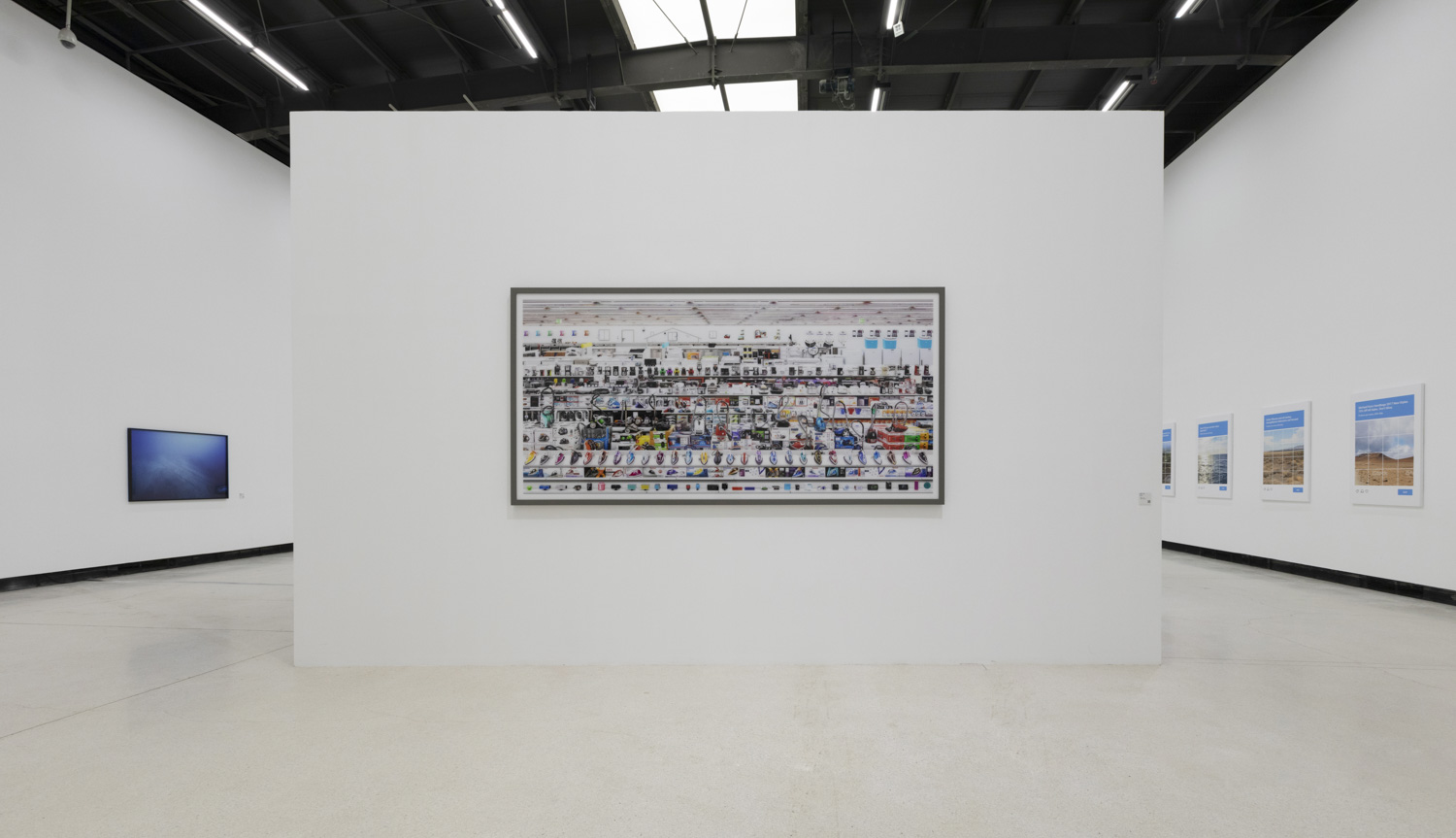
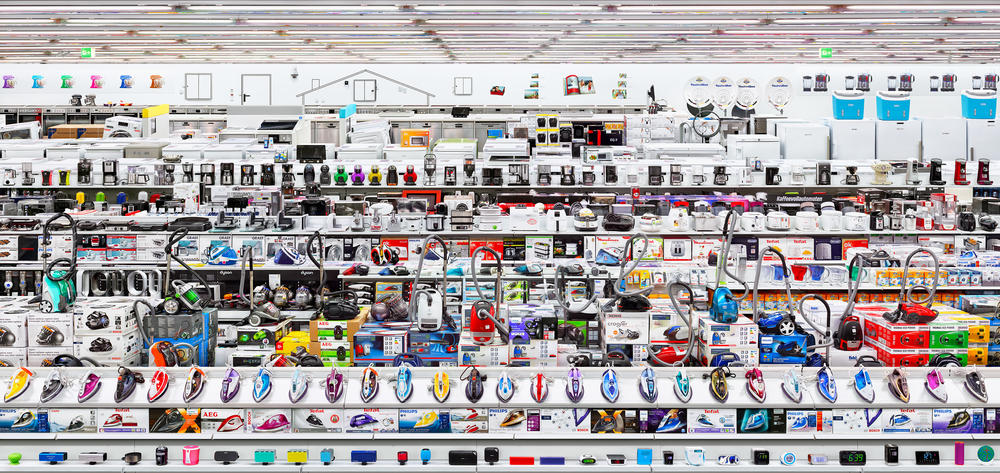
Andreas Gursky
Mediamarkt
2016
C-Print, Diasec
Courtesy Sprüth Magers
© Andreas Gursky / VG Bild-Kunst, 2021
Andreas Gursky has conducted an “extremely complicated” experiment in Mediamarkt. The artist presents the merchandise shelves of Mediamarkt, the largest retailer for consumer electronics in Europe, from the perspective of looking up and a massive, continuous, tightly integrated arrangement as well as the “full coverage focus”. The artist wove the details that can be described as “all-round” in the image, which endows the work with an overwhelming and dazzling momentum. It provides a certain possibility of “misunderstanding” for the audience. Are they commodities or pixels that make up the image?
Artist Evan Roth’s Since You Were Born (2019–2020) indicates a direct display of storage characteristics. He fills the visual space around visitors with his internet cache that captures the search histories from the day his second daughter was born on June 29, 2016. Engulfing snowflake-like stacks of images that include family photographs, banner advertisements, screenshots, logos of the websites he visited, etc. The artist embodies a view of the overwhelming mass of images we are exposed to by transforming online data into a technological creation.
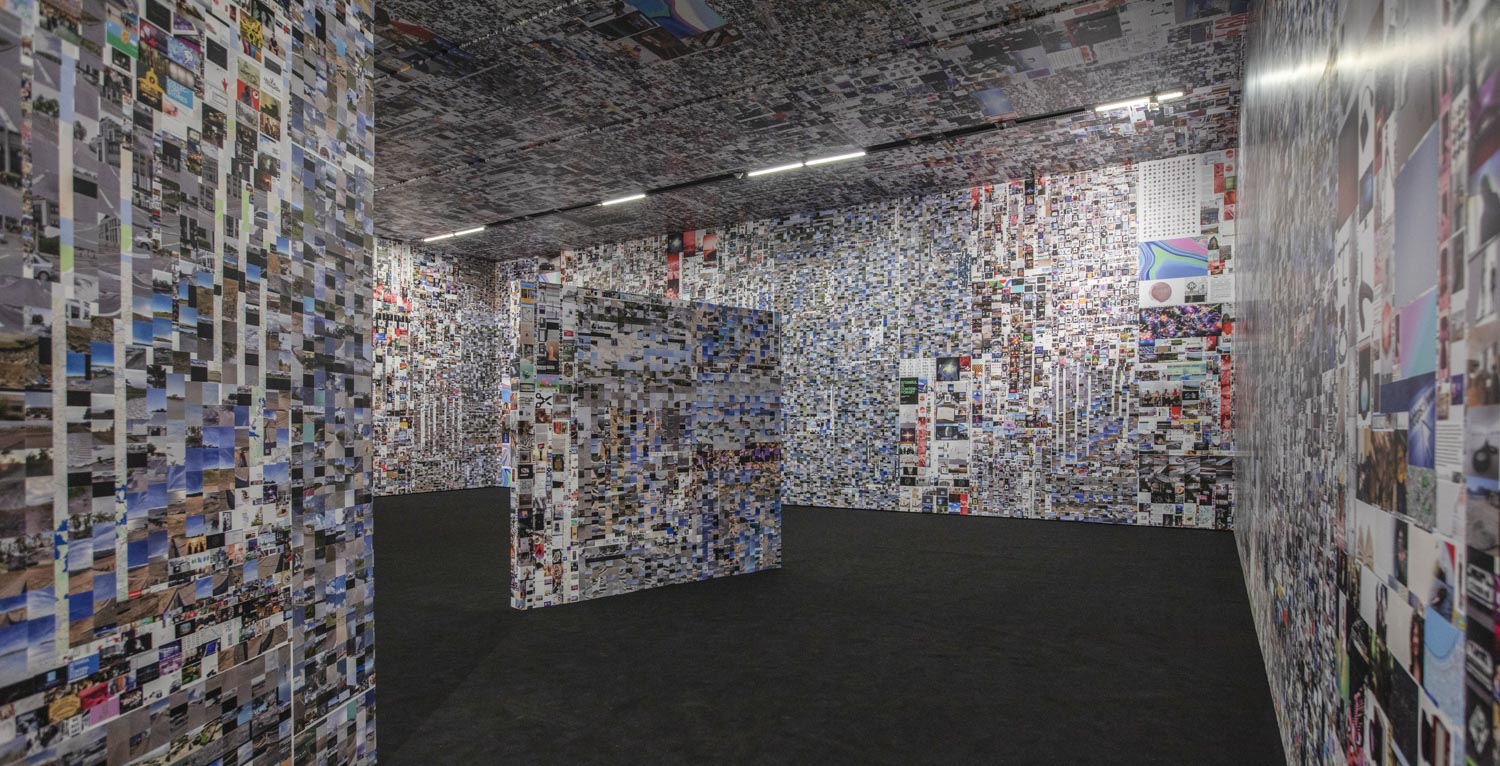
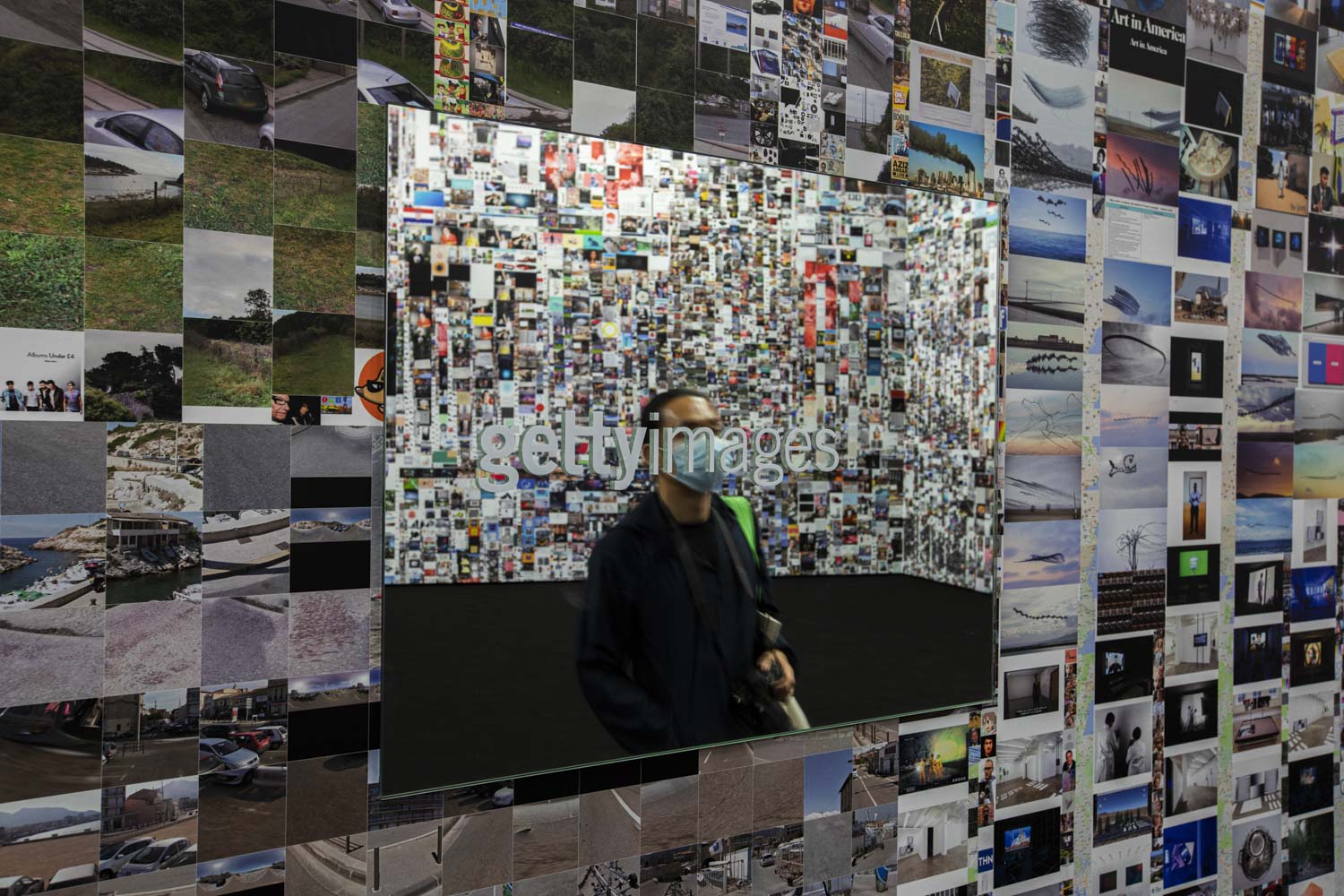
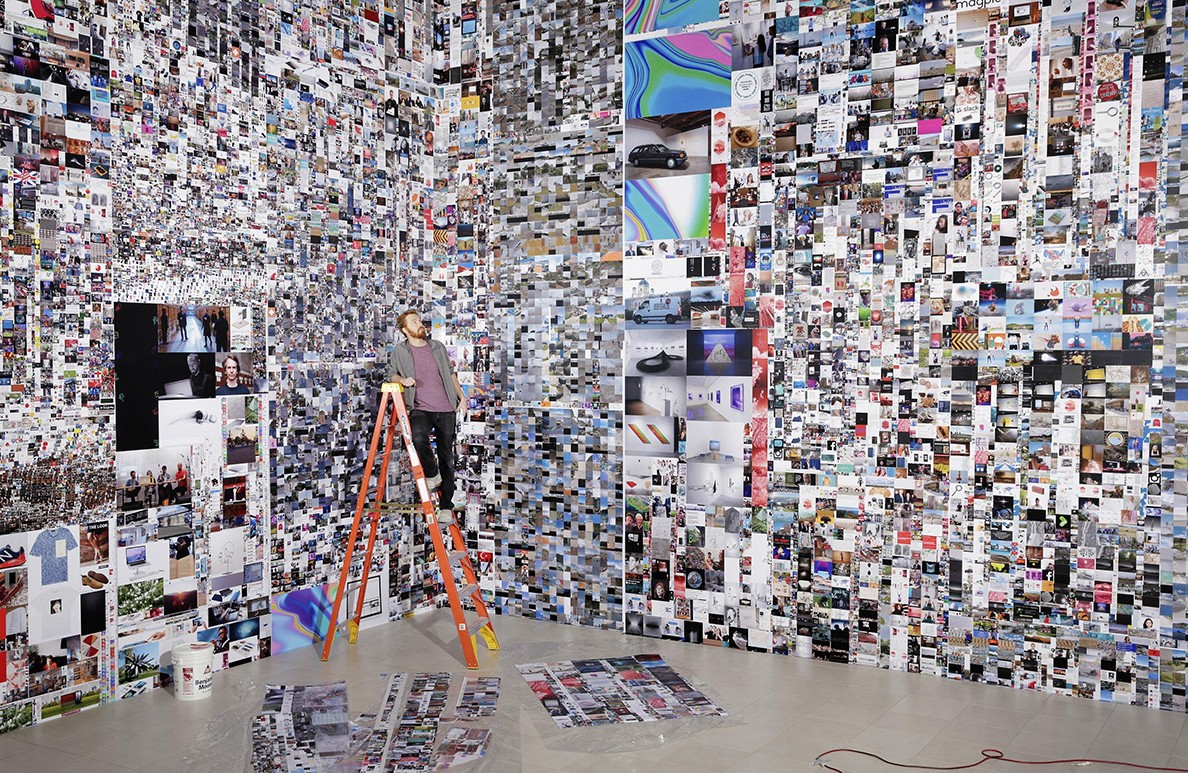
Evan Roth
Since You Were Born
2019–2021
Installation, images printed on vinyl
Courtesy of the artist © Photo by Bob Self/The Florida Times-Union / Courtesy of MOCA, Jacksonville, Florida
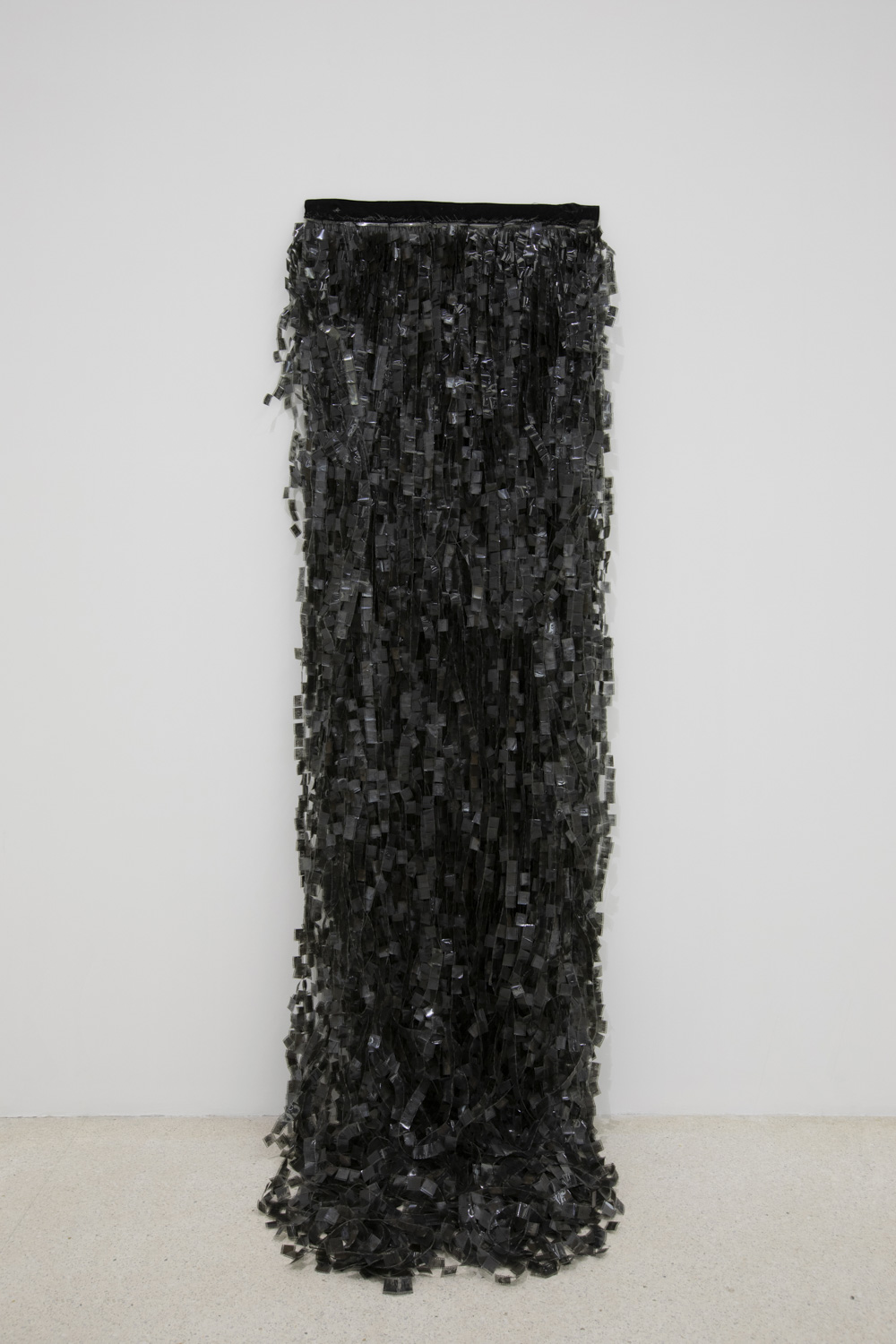
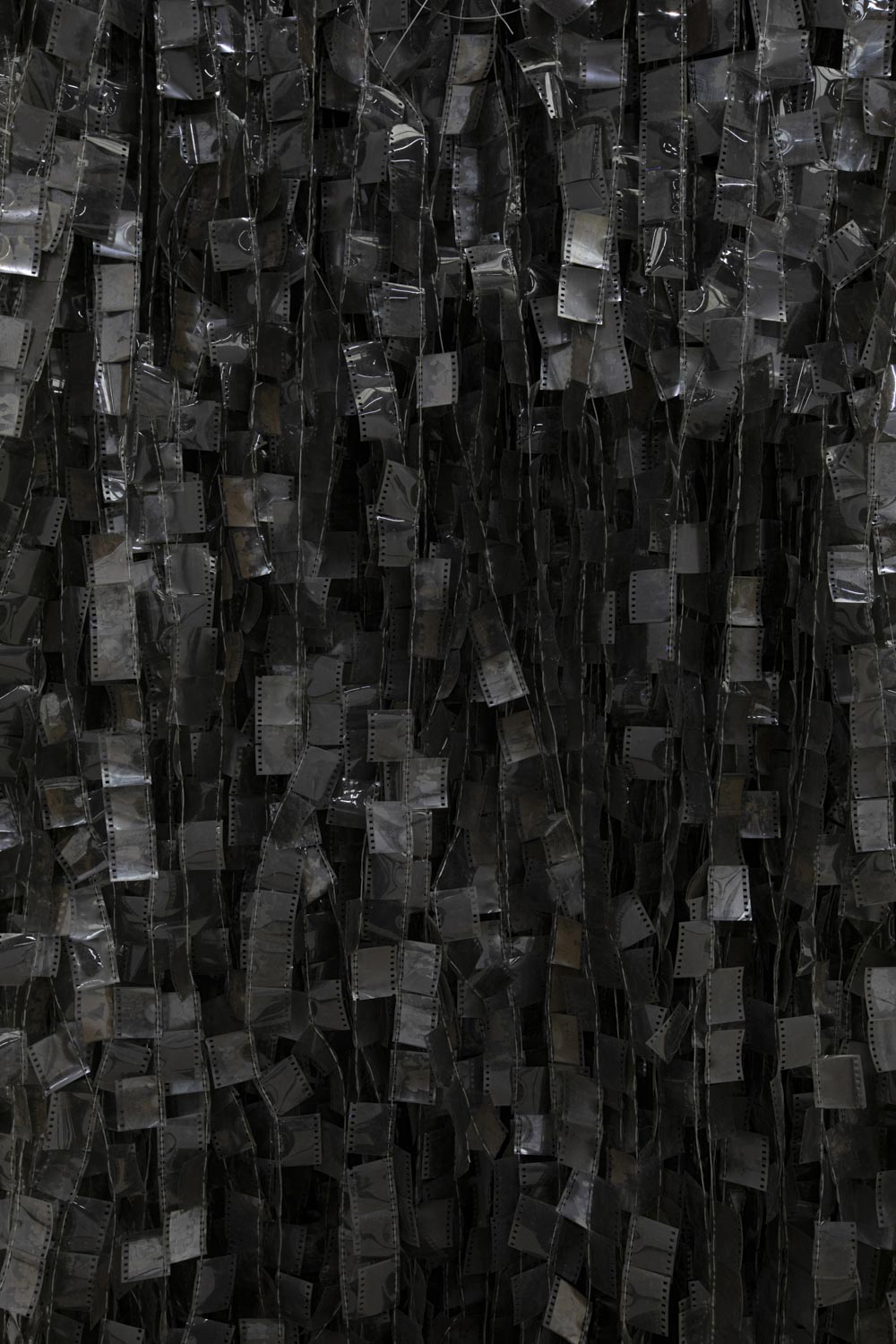
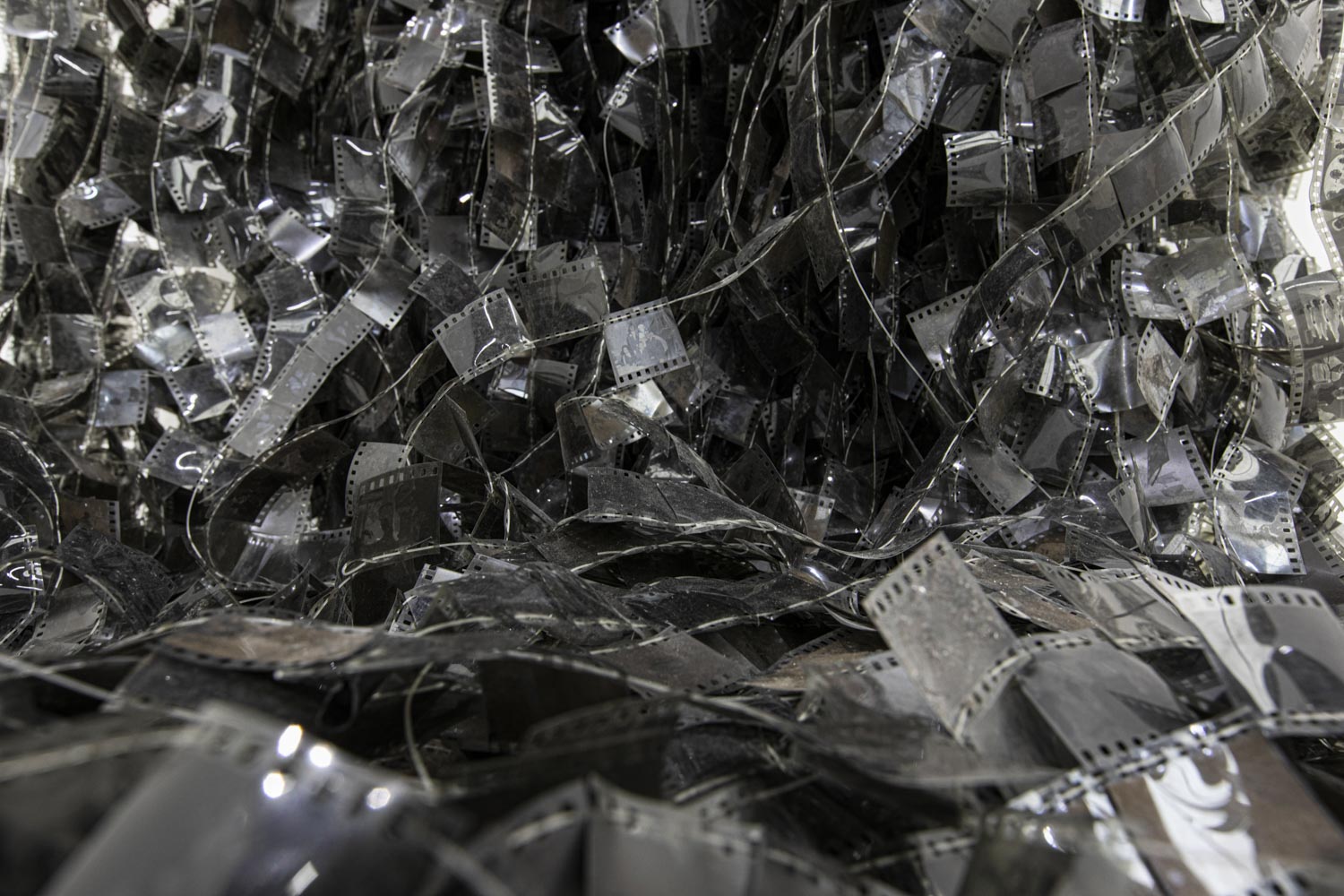
Exhibition View of Por Um Fio (1977-2004) by Ana Vitória Mussi
Por Um Fio by Ana Vitória Mussi (1977-2004) is composed of over 20,000 negatives that were taken by the artist during her tenure as a photo journalist in Rio de Janeiro from 1979 to 1989. Most of them focused on politicians, celebrities and entertainment stars. Their images are first of all restored to the material element in the work, and then they are turned into a slanting, shining waterfall. Everyone in the flux lost his name and even became illegible, they seemed to be discarded including the identities of celebrities who had the ability to manipulate politically during the dictatorship.
The difference between the storage form of digital images and the presentation form of images themselves, is responded to in the Second Chapter of “Raw Materials”, the quality of raw materials in images spans the digital world and real world. Relying on codes, Jeff Guess’ Addressability focuses on the decisive moment when the pixels are organized into a complete image, and the visibility of this moment reveals the characteristics of the raw materials in images, some unremitting and recurring fluidity.
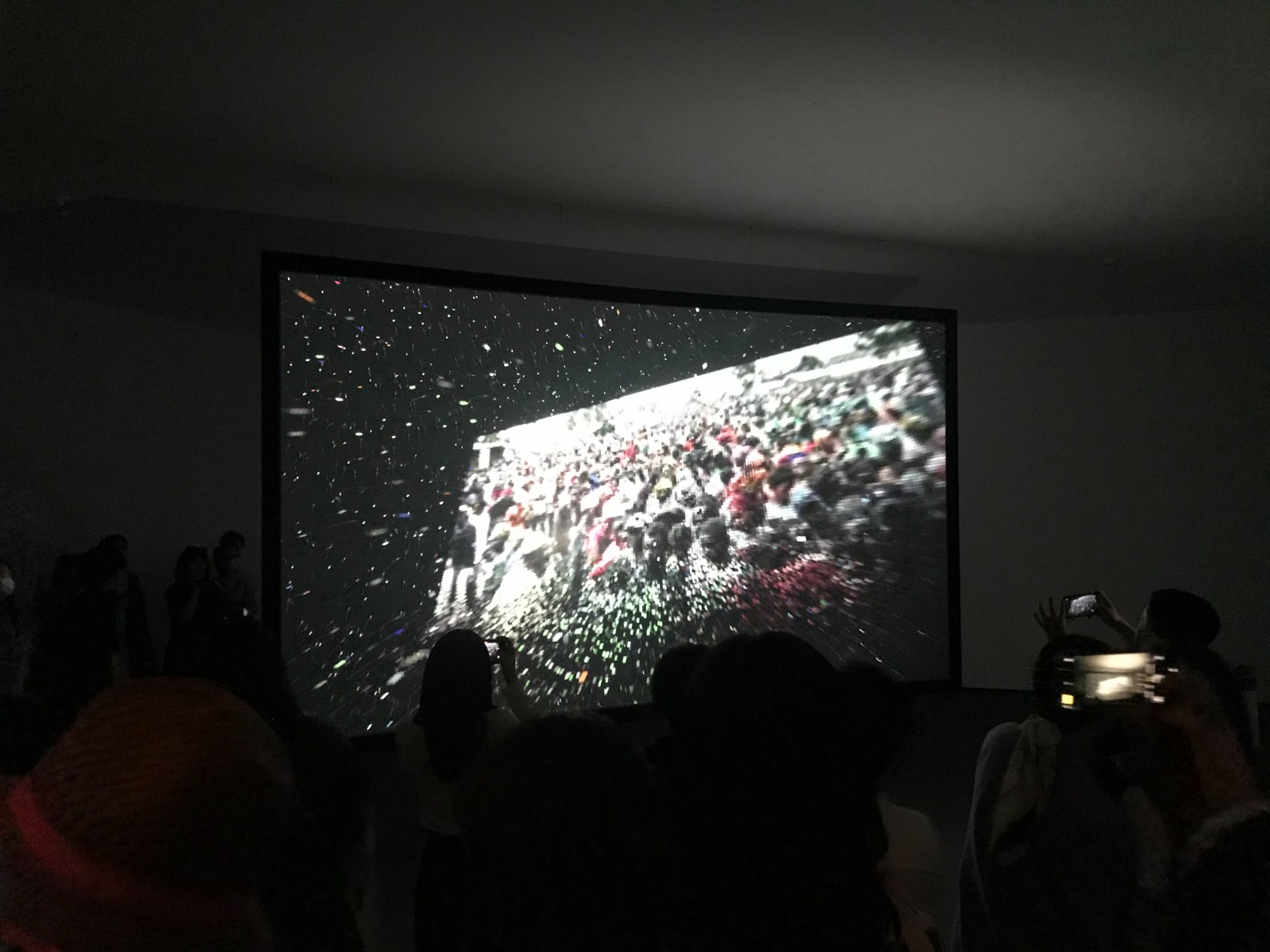
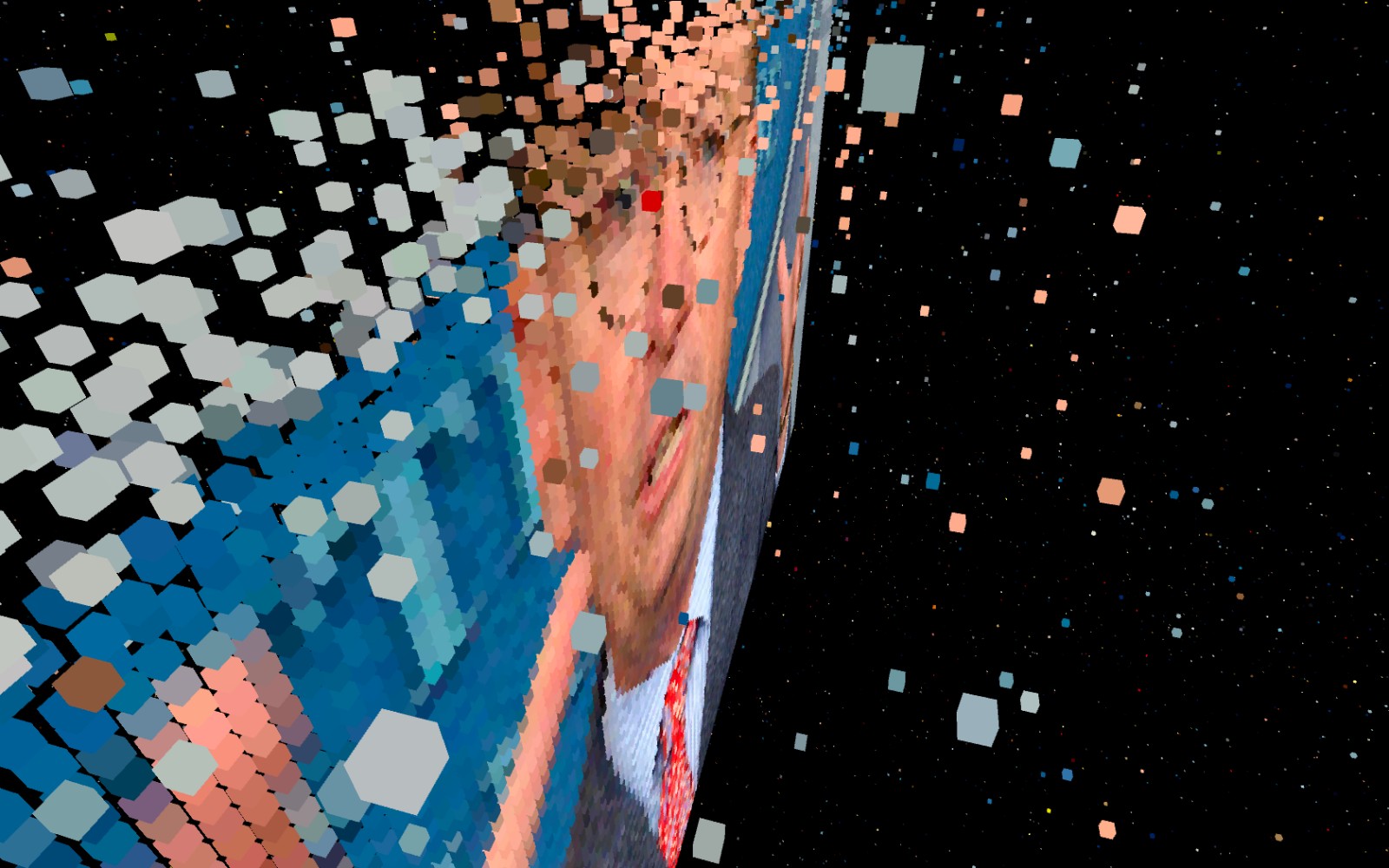
Jeff Guess
Addressability
2011
Custom software (Java, Processing, OpenGL, Node.js), Full HD video projector and suspended screen
Courtesy of the artist © Jeff Guess
In the field of social economics, the “invisible hand” refers to a concept developed by economist Adam Smith as a metaphor for the laws of the market which harmoniously regulate supply and demand. Visible Hand (2016) is an online artwork based on a sort of hand icon entirely composed of typographic ASCII characters. The figures and letters forming this Visible Hand are dynamic. They keep changing with the real-time variance of stock market indexes around the world. The ever-shifting picture alerts us to the fact that digital images have become increasingly dependent on the fluctuations of money, information, and energy. This hand is not the hand of Adam Smith to balance the financial markets. It is rather regulated by the markets themselves.
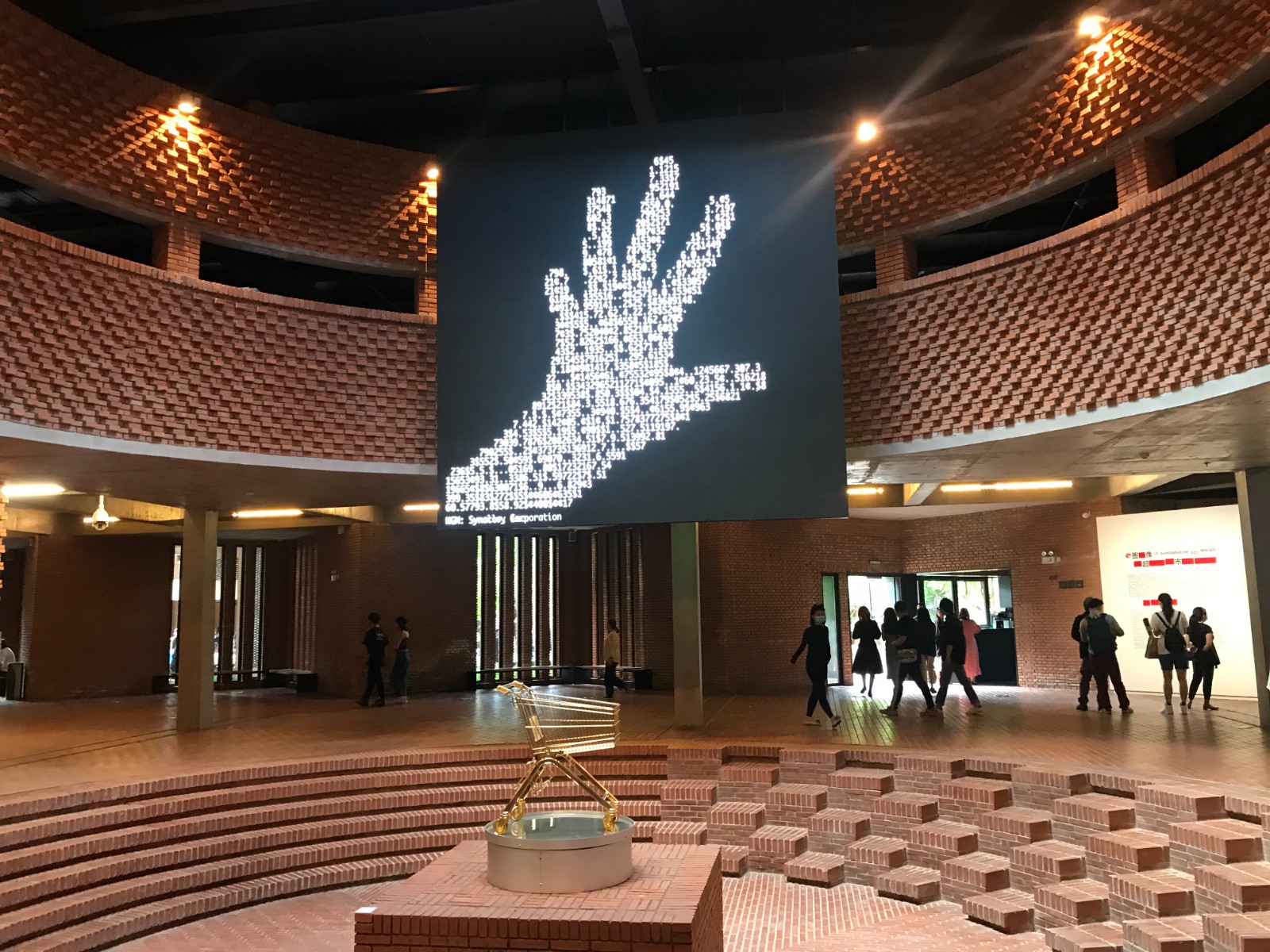
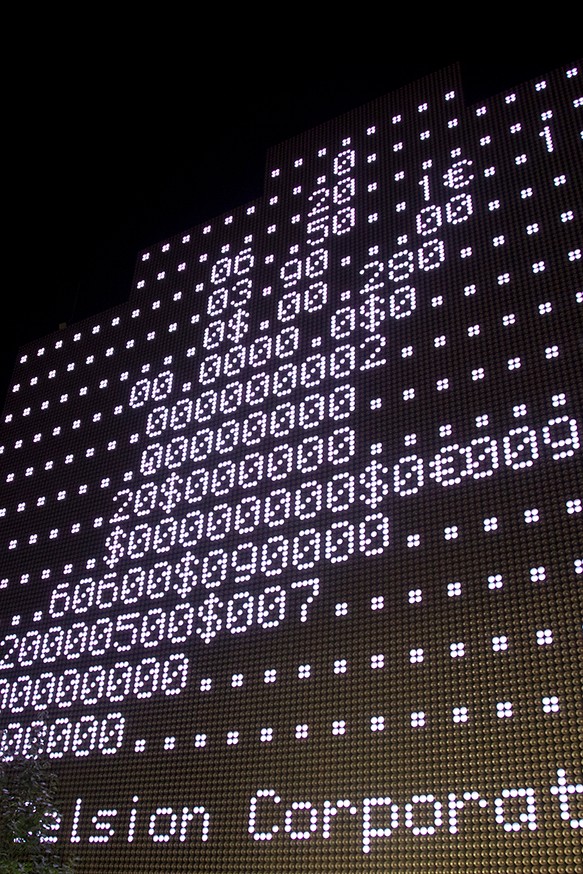
Samuel Bianchini
Visible Hand
2016
Online artwork, after the All Over project, produced by the Jeu de Paume, Paris, 2009
View of the installation on the façade of the Medialab-Prado, Madrid
Courtesy of the artist © Samuel Bianchini/ADAGP, Paris, 2021
The co-called “work” of images does not only imply the action of the photographer when he presses the shutter, “work” can be found in all aspects of the production, dissemination and storage of images, and it even includes the thumbing and scanning of the verification code. The sequence of works selected by “Work” of the Third Chapter examine the various aspects of image-based labor, and it unveils the issues aroused by “work” behind images. Among them, there are concerns about the exploitation of cheap labor (they support the smooth operation of the internet even if they are invisible), and reflections on the ethics of science and technology.
Martin Le Chevallier’s video Clickworkers (2017) shows us part of the answer. By watching the recording with a blank, monotonous backdrop, visitors experience a day in the real life of a “clickworker” who works around the clock for little pay. This video gives a voice to those who work in cooperation with the daily dissemination of information, exposing the harsh conditions in which they are exploited as cheap labor.

Martin Le Chevallier
Clickworkers
2017
HD colour video, sound, 8 min. 23 sec.
Courtesy of the artist and Galerie Jousse Entreprise, Paris © Martin Le Chevallier
Exhibition View of Screens in Rest (2017) by Liu Bolin at Red Brick Art Museum
Liu Bolin’s Screens in Rest is a frank expression of individual experience and thinking in the era of “iconomy”. Through a record of performance art, an individual covered with paint is integrated with media components such as TV screens stacked behind him. The visible image obscures the invisible work and people who are the carrier of the work as people are erased in the contemporary visual cultural landscape. However, it is precisely the practical human work that supports the visible and virtual world of images.
II. Money is the backup of images/Money is the texture of images
Peter Szendy mentioned in his speech at the opening ceremony that the concept of “iconomy” was directly inspired by Gilles Deleuze, the French left-wing philosopher, especially his precise description of film in Cinema 2: the Time-Image, “Film as art, it is also in a direct relationship of permanent conspiracy, experiencing an international conspiracy which dominates the film from the inside, just like the closest and the most indispensable opponent...Money is what the film shows and the backup of all images.” [2] Deleuze frankly pointed out that the fatal relationship between film and money, when money ran out, the film stopped. Therefore when compared to movies, do images share a similar connotation? Actually, the exhibition adopts the metaphor of “supermarket” and clarifies the direct relationship between the manipulator and money. All materials, inventory, work are necessary products surrounding the value and exchange of images.
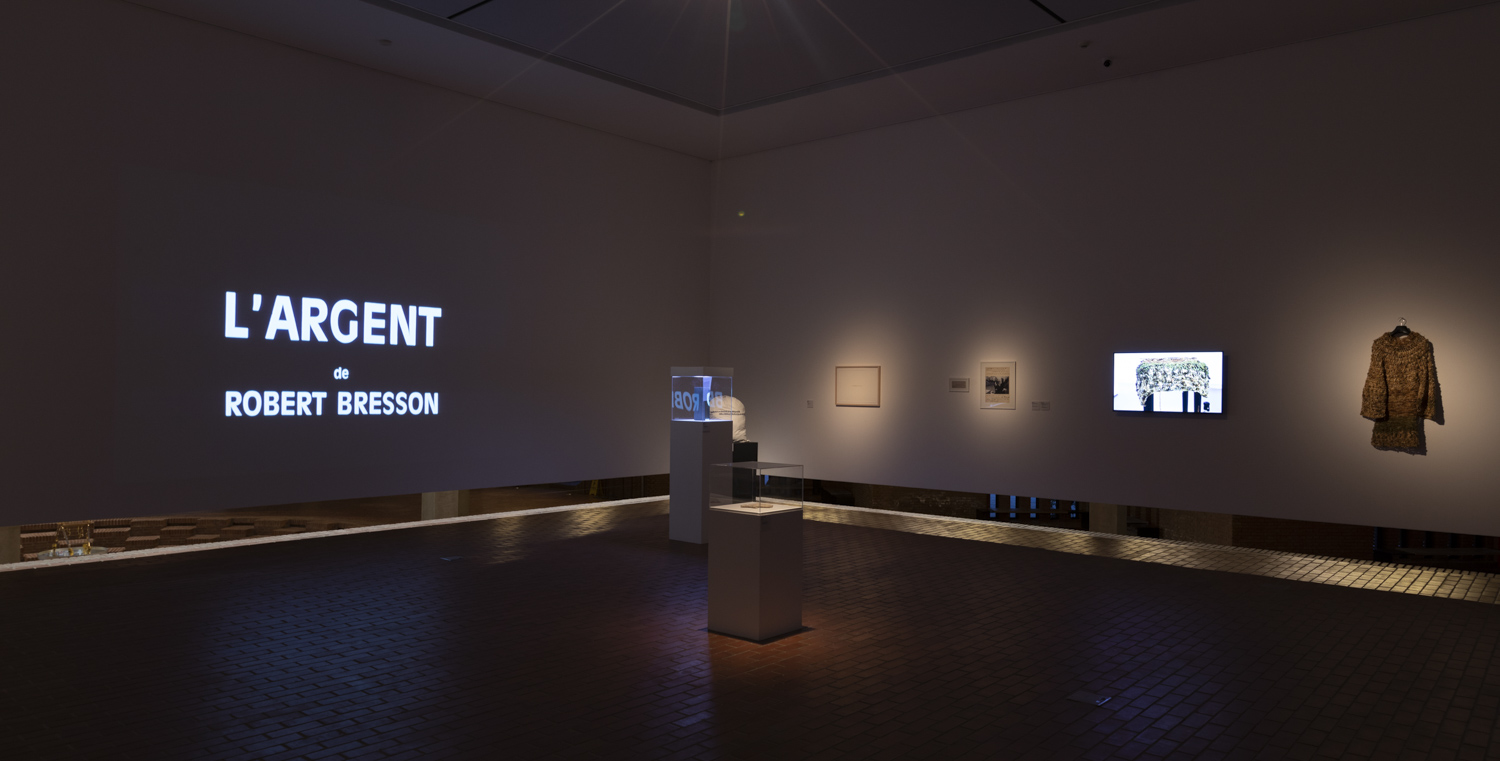
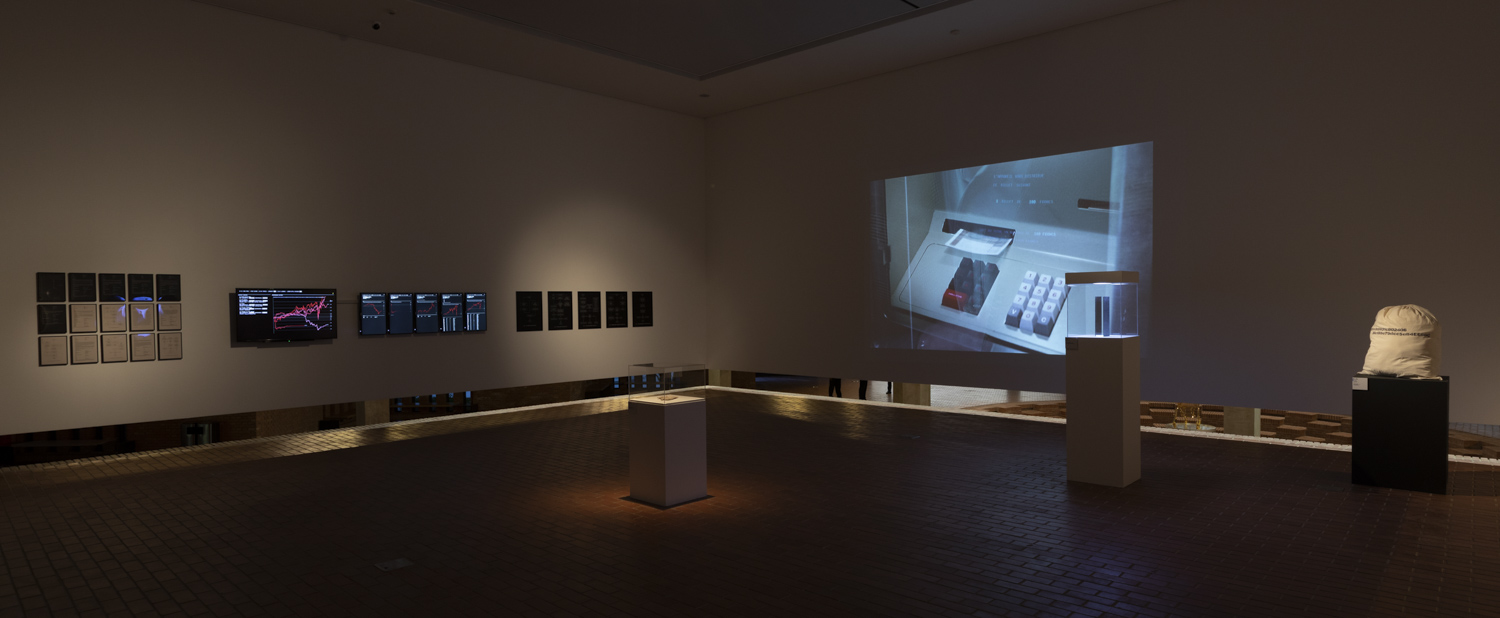
Exhibition View of “Le supermarché des images (The Supermarket of Images)”
Trailer for the film L’Argent by Robert Bresson is presented in the Fourth Chapter of “Values” and it announces the symbiosis of images and money with Bresson’s iconic editing rhythm.
When this kind of symbiosis affects the era of the emergence of Cryptoart, more artists are beginning to be interested in the act of payment itself and the possibility of the existence of artworks. Kevin Abosch has created ten million virtual artworks under the name I AM A COIN for his eponymous project, having placed hundreds with different addresses on the Ethereum blockchain before printing the addresses in ink on large canvas bags. The contents of the canvas bags have become a metaphor for “coins”, or what Abosch calls “pieces of myself”. Their hidden presence makes them “relics or personal effects”. He chooses to “[connect his] physical body to the virtual works” by stamping the contract address on the Ethereum blockchain, consisting of letters and numbers, in his own blood on 100 pieces of paper, thus making the work a part of himself.

Kevin Abosch
I AM A COIN
2018
Installation, blood stamped on paper
Courtesy of Studio Kevin Abosch © Studio Kevin Abosch

Yves Klein
Reçu pour les “Zones de sensibilité picturale immatérielle”
1962
Printed paper
Courtesy of the Estate Yves Klein c/o ADAGP, Paris © Succession Yves Klein c/o ADAGP, Paris, 2021/photo : Archives Yves Klein/ADAGP Images
Another attempt with a similar logic and artistic touch is probably Zones de sensibilité picturale immatérielle which is also included in this exhibition. It is a work conceived and put into practice from 1959, and it is actually a special art collection experiment designed by the artist. To put it simply, Yves Klein hopes that the collector will contribute “a certain weight of gold” to collect the non-material space (Klein said this is an invisible and intangible work), and let the collector destroy it after the transaction (burned) receipts, and the artist gave up half of the gold (thrown into the Seine River), and proved that the possession of intangible works of art by the collector all relied on some kind of “ceremony” conducted by Klein and the collector. The NFT that Cryptoart relies on is also similar to a “ritual”, but the ceremony actually relies on the Ethereum blockchain that creates a lot of energy loss problems, which does not seem to be important in the rise of Cryptoart. [3] This also makes the emergence of Cryptoart a rather complicated event of the “iconomy” from one aspect, which creates issues in the production, work, exchanges, and values suggested by many exhibitions.
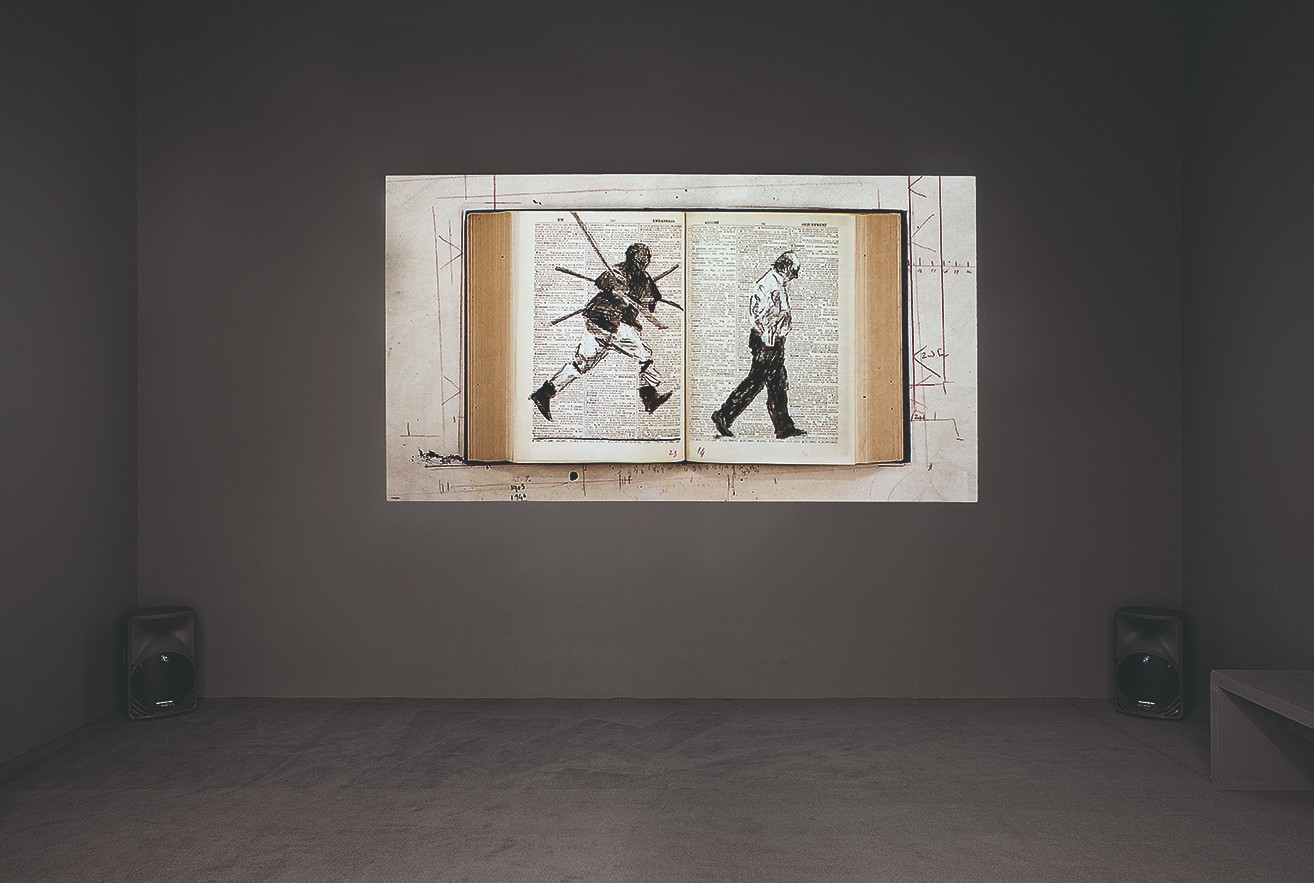
William Kentridge
Second-Hand Reading
2013
HD colour video, sound, 7 min. 1 sec.
Courtesy of the artist and Marian Goodman Gallery, New York/Paris/London © William Kentridge/photo : Cathy Carver
Because of the convenience of exchange and circulation, an image itself is a complex polymer. In the chapter of “Exchanges”, one can see the flowing and changing fate of an image itself, which is a product of uncertainty. If the Second-Hand Reading by William Kentridge in the exhibition uses books and images as the medium, it relies on reading, a familiar and cordial act of people, to show the characteristics of co-existence between a truthful record and fiction, which enables the image to have a space for multiple and poetic interpretations. Another work, The Pirate Cinema, brought by the group of “DISNOVATION.ORG”, which was established in Paris in 2021, demonstrates the flow (dissemination) ability and special texture of commercial images after pirated copying. Actually, such “inferior” images, led by pirated movies, fill almost every corner of our lives.
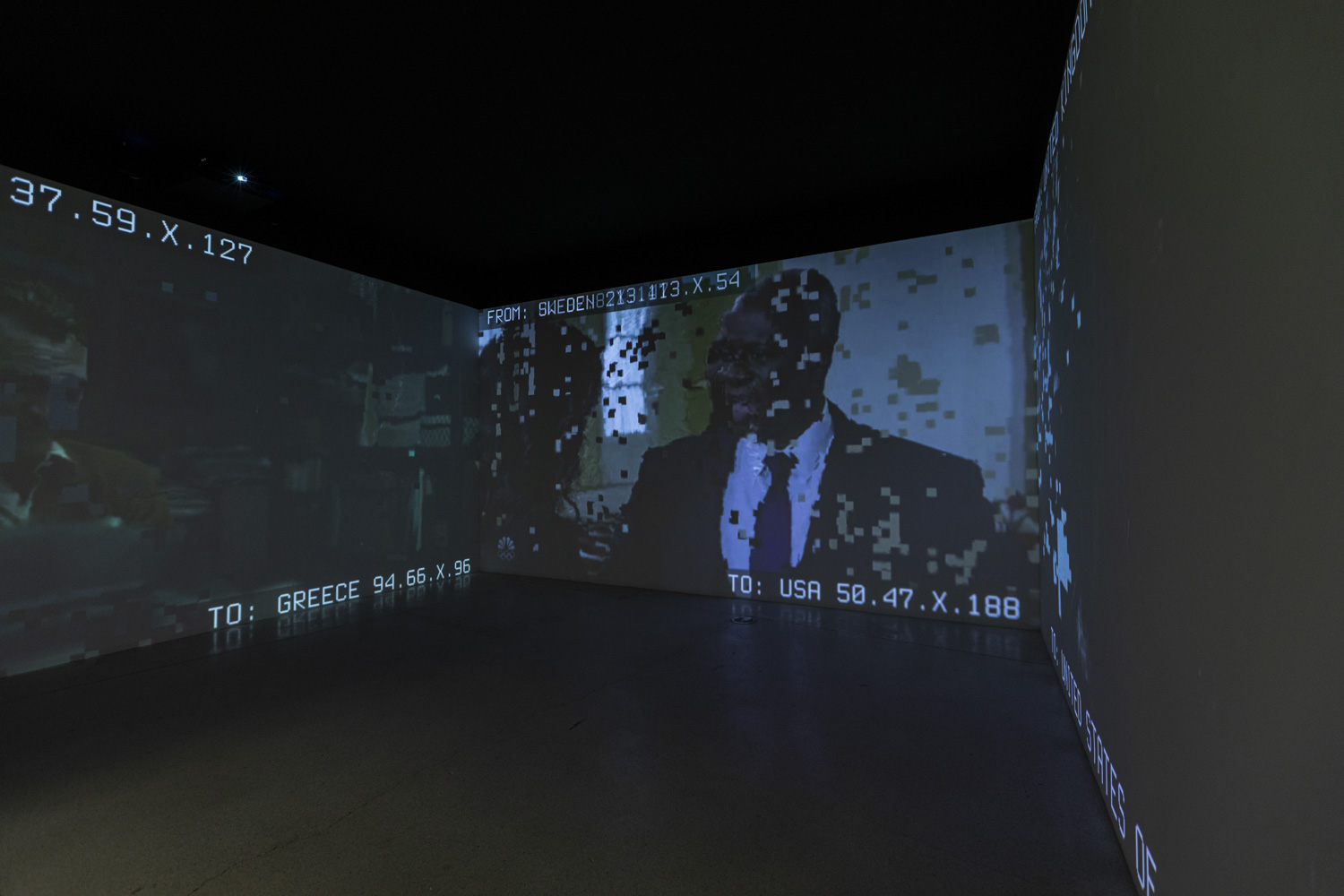
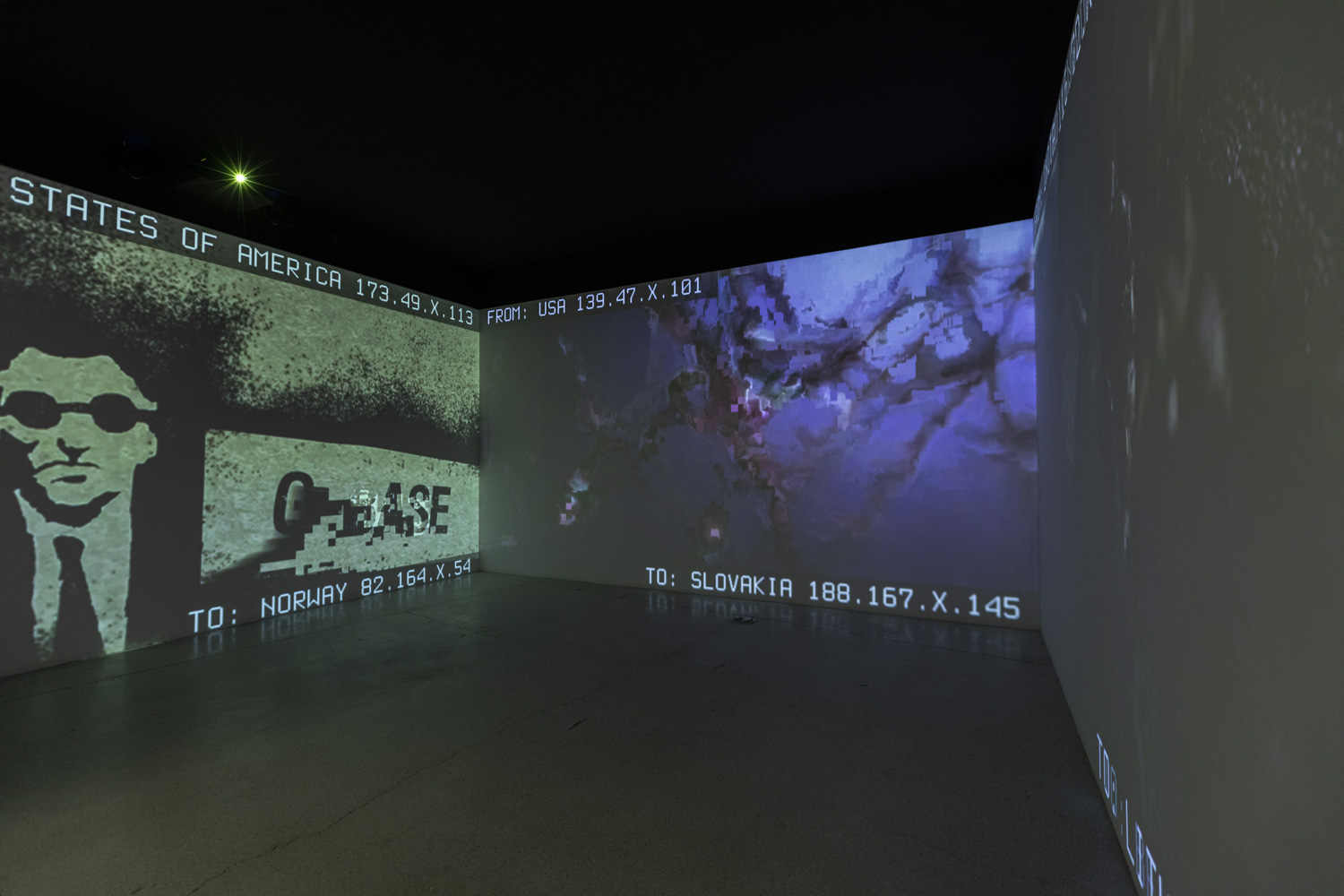
DISNOVATION.ORG, The Pirate Cinema, 2012–2014, Exhibition View of “The Supermarket of Images” at Red Brick Art Museum
The interest and purpose of “The Supermarket of Images” may not occur at the level of “image history” or “visual culture”, but rather stems from the critical consciousness triggered by various issues in the current era of “iconomy”. As the curator Peter Szendy stated in his speech, “In an era where images can be exchanged in general, this new system of image existence is a new comprehension that the exhibition is trying to explore.” It is indisputable that the “iconomy” is closely related to the world we live in today. It constructs, shapes, and changes each of us and the world around us. As individual producers and consumers of images, people can observe the great changes that are happening and will continue to take place in the era of “iconomy” through such an exhibition, and find their own “pixels” in order to obtain some reflection and action.
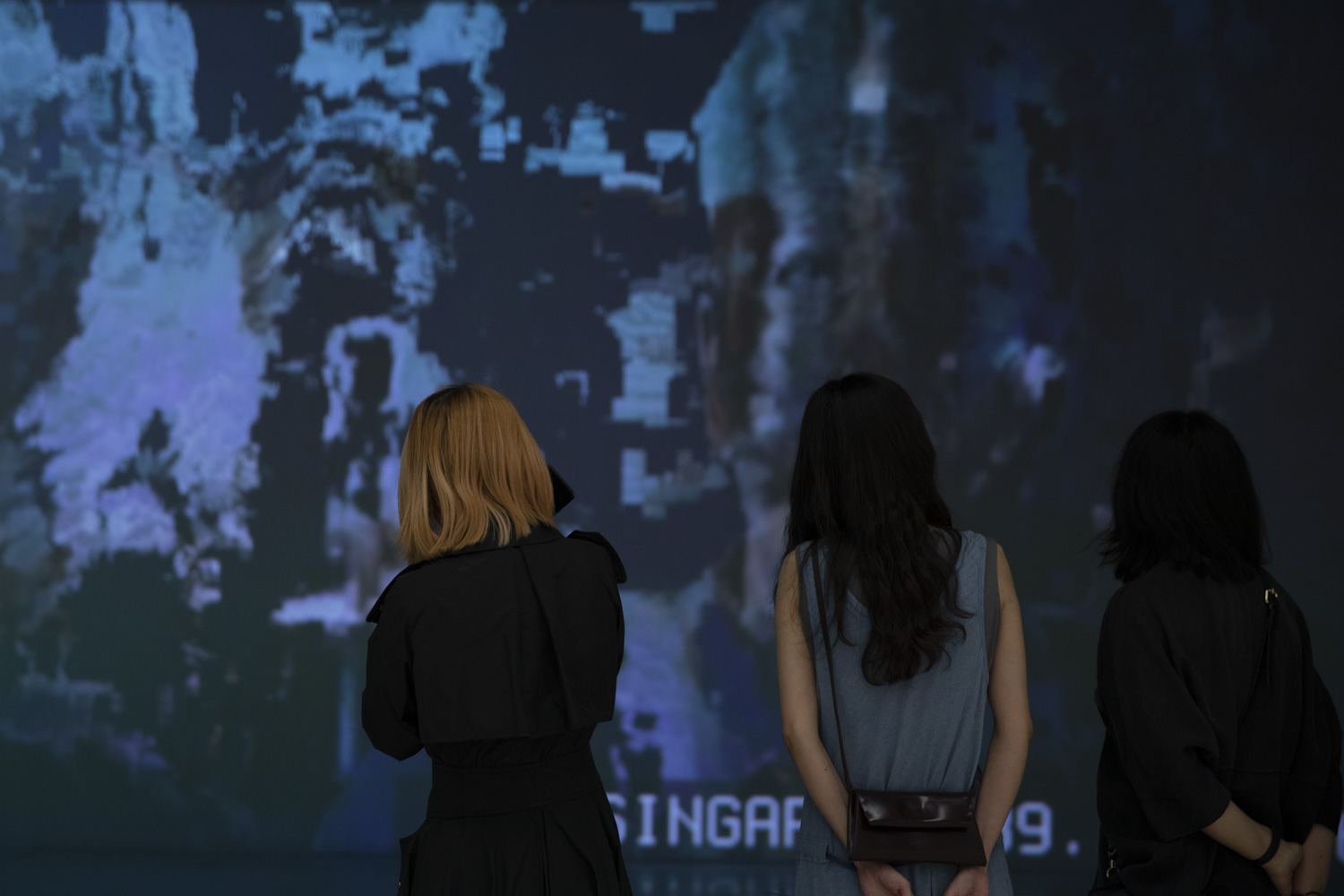
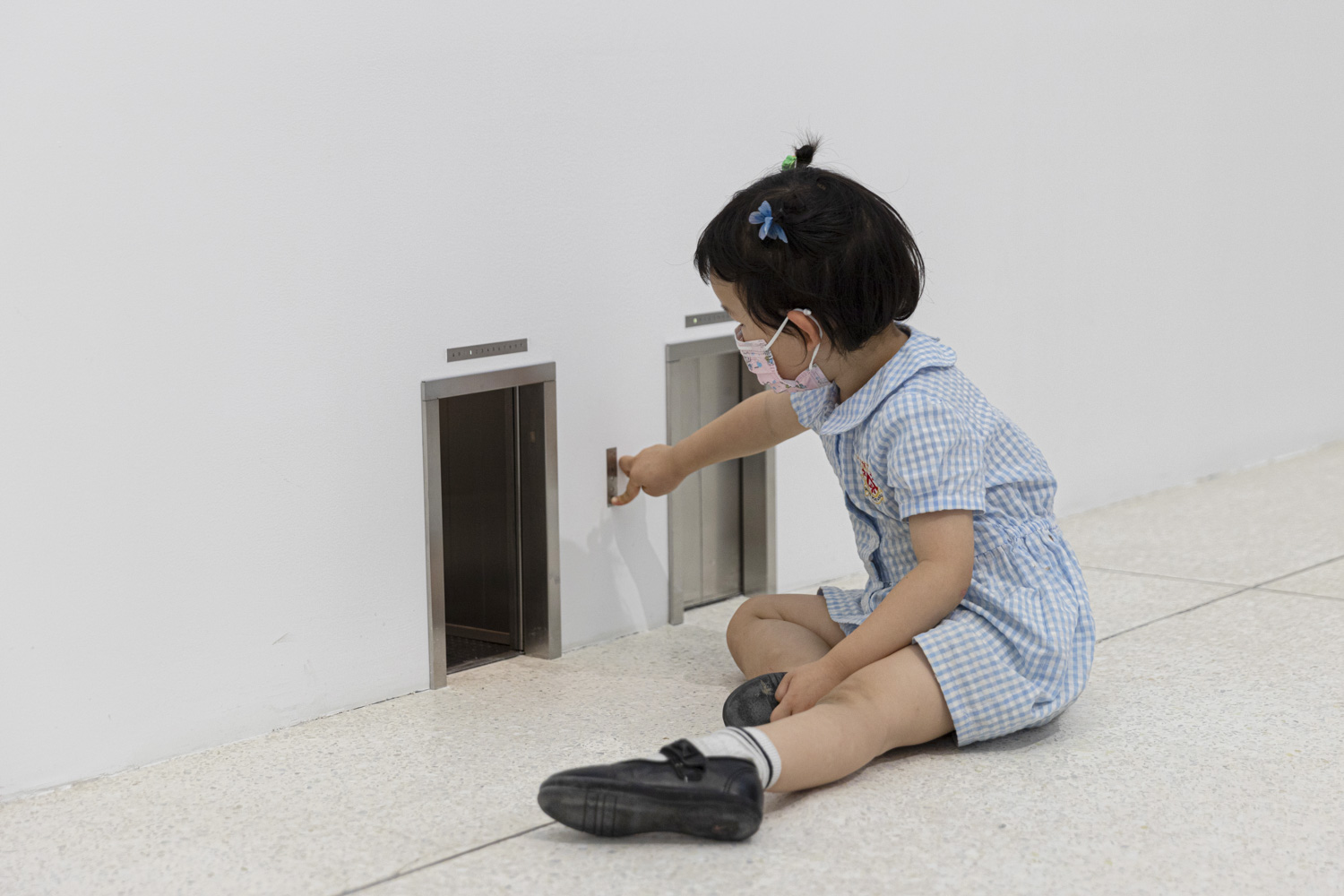
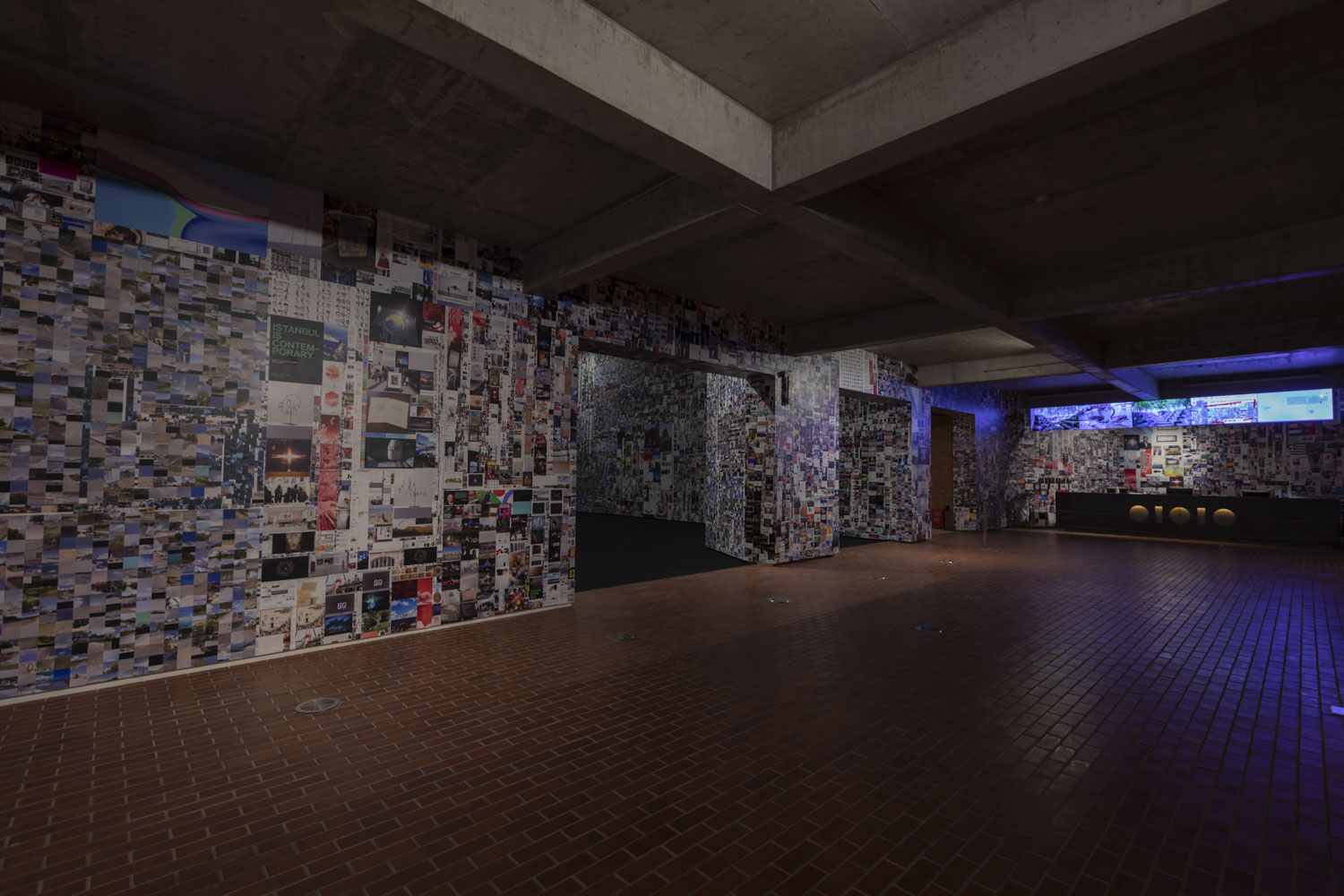
Exhibition View of “Le supermarché des images (The Supermarket of Images)”
The exhibition itself also makes people feel dizzy or even lost, just like the rich problematic consciousness it embodies and the vast images display. This is almost like a kind of vigilance, facing the ocean of images, people may never know the specific appearance of each wave. From another perspective, it vividly depicts the huge, complex, disorderly, and confusing situation that our iconomy era is maintaining.
In addition, “The Supermarket of Images”, as an important part of the 15th Le Festival Croisements, was co-organized by the French Embassy in China and Jeu de Paume, and was supported by Institut français de Pékin. The audience can still feel the aftermath of the thoughts of French left-wing philosophers. If it is said that in the book Time-Image, which inspired the curator, Deleuze worked hard to free images from the cinema and make it free. Then, in this exhibition, we may still be aware of a certain impulse to liberate images: it attempts to open up five paths of comprehension in the huge wave composed of images, to approach a certain essential attribute of the current images. The characteristics of this theoretical context are also faintly floating in the exhibition which was based on the plateau of criticism, it is so unique as well as powerful, and has a pioneering texture, but at the moment of construction, it reveals a gentle and modest aspect. Of course, if it is specific to a single exhibition, “construction” which is not always an appropriate requirement.
Text by Mengxi, edited and translated by Sue/CAFA ART INFO
Image Courtesy of Red Brick Art Museum
Notes
[1] Quoted from the press release of “Le supermarché des images (The Supermarket of Images)”
[2] Deleuze, G. (2004). Cinema 2: the Time-Image. Xie Qiang et al. Trans. Changsha: Hunan Fine Arts Publishing House. p121
[3] “The real problem is related to a currently inevitable feature of the way that NFT works. Every transaction on the Ethereum blockchain (most NFTs are currently recorded on the blockchain) involves a set of proof-of-work calculations. These calculations are deliberately designed to be energy-intensive. On a global scale, all processors participating in the verification of proof-of-work are running wildly, they consume a lot of energy while bringing about a huge environmental cost.” Quoted from Adam Greenfield’s point of view.
Available from: https://www.thepaper.cn/newsDetail_forward_128980

The curator of the Red Brick Art Museum Yan Shijie (first left) and the French Ambassador to China Mr. Luo Liang at the opening scene of the "Le supermarché des images" exhibition
French Ambassador to China Mr. Luo Liang at the press conference of the "Le supermarché des images" exhibition at the Red Brick Art Museum
Quentin Bajac (bottom left), the director of the Jeu de Paume, chief curator Peter Szendy (top center), and co-curator Marta Ponsa (top left), in Paris, participated in the meeting connection to the Red Brick Art Museum on "Le supermarché des images" Exhibition Press Conference
About the exhibition

Curator: Peter Szendy
Associated curators: Emmanuel Alloa, Marta Ponsa
Dates: May 29 – August 1, 2021
Organised by: Red Brick Art Museum
Co-organised with: Jeu de Paume、Ambassade de France en Chine
Supported by: Institut français de Pékin
Artists:
Kevin Abosch, Aram Bartholl, Taysir Batniji, Samuel Bianchini, Robert Bresson, Ben Thorp Brown, Sophie Calle, Maurizio Cattelan, Emma Charles, Chia Chuyia, Max de Esteban, DISNOVATION.ORG, Harun Farocki & Antje Ehmann, Sylvie Fleury, Máximo González, Jeff Guess, Andreas Gursky, Lauren Huret, Geraldine Juárez, William Kentridge, Yves Klein, Martin Le Chevallier, Li Hao, Liu Bolin, Auguste & Louis Lumière, Elena Modorati, Lázló Moholy-Nagy, Ana Vitória Mussi, Trevor Paglen, Julien Prévieux, Wilfredo Prieto, Rosângela Rennó, Hans Richter, Martha Rosler, Evan Roth, Thomas Ruff, RYBN.ORG, Hito Steyerl, Wang Qingsong




























